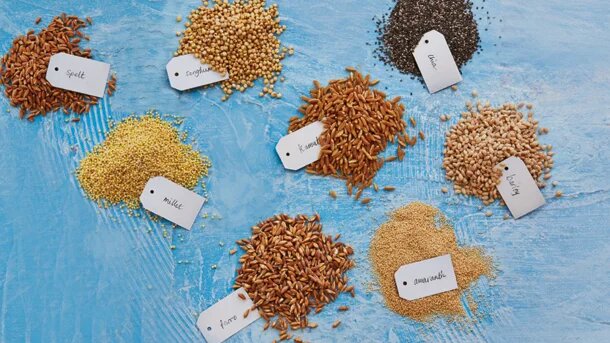Ancient Grain In A Healthy Cereal Nyt – A Comprehensive Guide!
When we think of cereal, the first image that comes to mind is often a bowl of crunchy flakes or sweetened oats. But in recent years, there’s been a growing interest in incorporating ancient grains in a healthy cereal. These grains, often forgotten in favor of more modern crops, have been rediscovered for their nutritional benefits and unique flavors.
Ancient grains in a healthy cereal, as discussed by the NYT, offer a nutritious alternative to conventional cereals. They are rich in fiber, protein, and essential nutrients, making them an excellent choice for a balanced, wholesome breakfast option.
This article will dive deep into why ancient grains are making their way into our breakfast bowls and why they should be part of a balanced diet.
What Are Ancient Grains?
Ancient grains are varieties of grains that have remained largely unchanged for centuries, if not millennia. Unlike modern grains that have been heavily altered through selective breeding and genetic modifications, ancient grains in a healthy cereal maintain their original genetic structure. These grains include quinoa, farro, spelt, millet, and teff, among others. They’re typically grown with fewer chemical pesticides, and they often contain more vitamins, minerals, and fiber than conventional grains.
The Rising Popularity of Ancient Grains in Modern Diets!
In recent years, ancient grains have become a popular choice for a healthy cereal, and they are now seen as a staple in many diets. This shift is mainly due to people’s growing interest in healthier and more sustainable food choices. As more individuals become aware of the health risks linked to eating processed foods, many are turning to ancient grains as a natural alternative. These grains are seen as nutrient-rich, providing essential vitamins and minerals that support overall health. The move toward these grains reflects a desire for food that is both wholesome and better for the body.

Ancient grains are gaining popularity among a wide range of people, especially those with specific dietary needs. For example, individuals who need gluten-free options are increasingly choosing ancient grains in their cereal. In addition, people looking to boost their protein intake are also turning to these grains. They offer a great way to add protein to the diet without relying on animal-based products. The rise of ancient grains in healthy cereal options is making it easier for people to meet their nutritional goals while enjoying a tasty, natural meal.
The Health Benefits of Ancient Grains!
1. Nutritional Value of Ancient Grains:
One of the biggest reasons for the popularity of ancient grains in a healthy cereal is their impressive nutritional profile. These grains are often high in fiber, which can aid digestion and promote a healthy gut. Many ancient grains in a healthy cereal are also packed with essential vitamins and minerals, including B vitamins, iron, magnesium, and zinc. Compared to conventional grains like white rice or refined wheat, ancient grains in a healthy cereal offer superior nutrition.
2. Ancient Grains and Heart Health:
Several ancient grains in a healthy cereal have been shown to benefit heart health. For example, oats, one of the most commonly used ancient grains, are high in soluble fiber, which can help lower cholesterol levels. Quinoa and spelt also have heart-healthy benefits, such as being rich in antioxidants, which protect the body against oxidative stress that can damage the heart.
3. Impact of Ancient Grains on Digestive Health:
The high fiber content in ancient grains in a healthy cereal makes them excellent for digestive health. Fiber plays a critical role in regulating bowel movements and preventing constipation. By including ancient grains in a healthy cereal, you can support a healthy gut microbiome, which is crucial for overall digestion and absorption of nutrients.
4. Ancient Grains and Weight Management:
For those looking to maintain or lose weight, ancient grains in a healthy cereal can be a game-changer. The combination of protein, fiber, and complex carbohydrates in these grains can help you feel fuller longer, reducing the likelihood of overeating throughout the day. They provide long-lasting energy without the blood sugar spikes often associated with more refined cereals.
Why Should You Include Ancient Grains in Your Cereal?
Including ancient grains in your cereal is an excellent way to increase the nutrients you get from your meals. Ancient grains like quinoa, farro, and amaranth are full of fiber, which can help keep you feeling full longer. This is especially helpful for people who are trying to manage their weight or avoid overeating. The fiber in these grains also supports healthy digestion, making it easier for your body to process food and absorb nutrients. By choosing a cereal with ancient grains, you’re not only adding variety to your breakfast but also giving your body a boost of important nutrients.
In addition to fiber, ancient grains are packed with vitamins and minerals that help maintain your energy levels throughout the day. These grains are a good source of B vitamins, which support your metabolism and help your body produce energy. They also contain important minerals like magnesium, iron, and zinc, which are essential for your overall health. Whether you want to improve heart health, maintain energy, or simply enjoy a more balanced diet, adding ancient grains to your cereal is a simple and effective way to reach your health goals.
Read: Make1m.Com Dollars – Your Blueprint To Becoming A Millionaire!
How Ancient Grains Fit Into a Healthy Cereal?
1. Choosing the Right Ancient Grains for Cereal:
Not all ancient grains are created equal, and some are better suited for use in cereals than others. When selecting ancient grains in a healthy cereal, you’ll want to consider factors like flavor, texture, and nutritional value. Quinoa and amaranth are often chosen for their mild, nutty flavors and versatility. They pair well with both sweet and savory toppings, making them ideal for breakfast cereals.
2. The Best Ancient Grains for Breakfast:
Some of the best ancient grains in a healthy cereal include quinoa, farro, and oats. These grains are easy to cook, versatile, and have a satisfying texture. They can be mixed with milk or plant-based alternatives, topped with fruit, nuts, and seeds, and flavored with cinnamon or honey for a nutritious and filling breakfast.
3. How to Prepare and Cook Ancient Grains for Cereal:
Cooking ancient grains in a healthy cereal is simple. Most grains can be cooked similarly to how you would cook rice or oatmeal. For example, quinoa should be rinsed thoroughly before cooking to remove any bitterness. Farro requires simmering in water for about 30 minutes to achieve a tender, chewy texture. Once cooked, you can mix these grains with your favorite toppings to create a wholesome, filling breakfast.
Ancient Grains vs. Modern Grains: A Comparison!
When you compare ancient grains to modern grains like white rice or wheat, the differences in nutrition are clear. Ancient grains are usually richer in fiber, protein, vitamins, and minerals. For example, quinoa has more protein than regular rice, making it a great choice for those needing more protein in their diet. Farro, another ancient grain, contains more fiber than white wheat, which can help improve digestion and keep you feeling full longer. By choosing ancient grains over processed cereals, you’re getting a healthier, more balanced breakfast that’s packed with essential nutrients.

Although modern grains can offer some health benefits, ancient grains are generally the better option for your overall health. They are higher in important nutrients like fiber and protein, which help keep your body strong and energized. Ancient grains are also less likely to cause blood sugar spikes compared to refined grains like white rice or wheat. If you’re aiming to improve your diet and health, opting for ancient grains in your cereal is a smart choice.
Incorporating Ancient Grains into Your Daily Diet!
1. Easy Ways to Add Ancient Grains to Your Breakfast Routine:
Incorporating ancient grains in a healthy cereal into your breakfast is easier than you might think. Start by replacing your regular cereal with quinoa, amaranth, or farro. You can also try making a grain-based porridge or mixing ancient grains with yogurt for a protein-packed breakfast.
2. Snack Ideas with Ancient Grains:
You can even enjoy ancient grains in a healthy cereal as a snack. Try making ancient grain granola bars or mixing cooked quinoa with dried fruit and nuts for a nutritious snack on the go.
FAQs:
1. Can Ancient Grains Help in Managing Blood Sugar Levels?
Yes, ancient grains in a healthy cereal can help regulate blood sugar levels. Grains like quinoa and oats have a low glycemic index, meaning they don’t cause a rapid spike in blood sugar levels.
2. Are Ancient Grains Gluten-Free?
Some ancient grains, like quinoa and millet, are naturally gluten-free. However, grains like farro and spelt do contain gluten, so it’s important to check the specific grain before incorporating it into a gluten-free diet.
3. What Are Some Common Ancient Grains to Include in Cereal?
Common ancient grains to include in a healthy cereal are quinoa, farro, spelt, amaranth, and millet. These grains are packed with nutrients and make an excellent addition to your breakfast.
4. How Do Ancient Grains Support Sustainable Agriculture?
Ancient grains are more resilient to harsh growing conditions and require fewer chemical inputs, making them a more sustainable crop. Their ability to thrive in diverse climates helps promote eco-friendly farming practices.
5. How Can I Make My Own Ancient Grain Cereal at Home?
Making your own ancient grains in a healthy cereal is simple. Cook grains like quinoa, farro, or oats, and mix them with your favorite toppings such as nuts, seeds, dried fruit, and a sweetener like honey or maple syrup. You can customize your homemade cereal to suit your tastes and nutritional needs.
Conclusion:
As we’ve seen, ancient grains in a healthy cereal offer a variety of health benefits, from improving digestive health to supporting heart health and weight management. These grains are also a sustainable choice for the planet, offering an eco-friendly alternative to modern grains. With their superior nutrition and versatility, ancient grains in a healthy cereal are here to stay, offering us a tasty and healthy way to start the day.



































































Post Comment